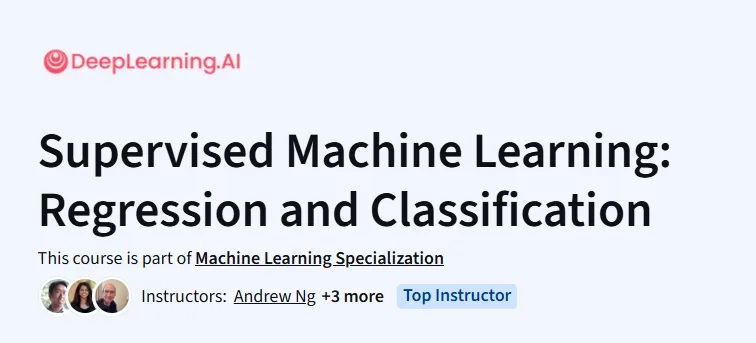What will you learn in Supervised Machine Learning: Regression and Classification Course
Understand key machine learning concepts: supervised vs. unsupervised learning, bias–variance trade-off, and model evaluation.
Implement algorithms such as linear regression, logistic regression, neural networks, support vector machines, and clustering.
Apply best practices for training, tuning, and deploying models, including regularization, cross-validation, and feature selection.
Gain practical experience coding ML algorithms from scratch and using Octave/MATLAB to solidify understanding.
Develop intuition for when and how to apply different ML techniques to real-world problems.
Program Overview
Week 1: Introduction & Linear Regression with One Variable
⏳ 3 hours
Topics: Course logistics, data representations, linear regression algorithm, cost function, gradient descent.
Hands-on: Implement linear regression in Octave; explore feature scaling and convergence.
Week 2: Linear Regression with Multiple Variables
⏳ 4 hours
Topics: Multivariate linear regression, normal equation, polynomial regression, feature normalization.
Hands-on: Compare gradient descent and normal equation approaches on housing price datasets.
Week 3: Logistic Regression & Regularization
⏳ 4 hours
Topics: Classification with logistic regression, decision boundaries, cost function adaptation, regularization to prevent overfitting.
Hands-on: Build a spam classifier; tune regularization parameter and visualize decision regions.
Week 4: Neural Networks: Representation
⏳ 3 hours
Topics: Biological vs. artificial neurons, network architectures, forward propagation, activation functions.
Hands-on: Implement feedforward propagation for a two-layer neural network.
Week 5: Neural Networks: Learning
⏳ 4 hours
Topics: Backpropagation algorithm, gradient checking, random initialization, hyperparameter tuning.
Hands-on: Train a neural network for handwritten digit recognition (MNIST); experiment with hidden layer sizes.
Week 6: Advice for Applying Machine Learning & Support Vector Machines
⏳ 5 hours
Topics: Error analysis, bias–variance trade-off, train/validation/test splits, support vector machines (SVMs), kernels.
Hands-on: Implement SVM classifier with Gaussian kernels for non-linear classification tasks.
Week 7: Unsupervised Learning & Anomaly Detection
⏳ 3 hours
Topics: K-means clustering, dimensionality reduction with PCA, anomaly detection using Gaussian models.
Hands-on: Cluster data with K-means; apply PCA for visualization; detect anomalies in network traffic logs.
Week 8: Recommender Systems & Large-Scale ML
⏳ 3 hours
Topics: Collaborative filtering, low-rank matrix factorization, stochastic gradient descent, MapReduce overview.
Hands-on: Build a basic movie recommendation engine; discuss scaling ML with distributed computing.
Get certificate
Job Outlook
Roles: Machine Learning Engineer, Data Scientist, Research Scientist, AI Specialist.
Demand: Strong across tech, finance, healthcare, and e-commerce, with companies seeking practitioners who can bridge theory and application.
Salaries: Entry-level positions typically start at $90K–$120K; experienced ML engineers earn $130K–$180K+.
Growth: Mastery of core ML algorithms and best practices opens doors to advanced roles in AI research, product development, and leadership.
Specification: Supervised Machine Learning: Regression and Classification
|
FAQs
- A basic understanding of linear algebra and probability is helpful.
- You don’t need advanced calculus to follow along.
- The course explains core concepts in a beginner-friendly way.
- Hands-on coding helps reinforce the math intuitively.
- Stronger math skills can enhance your learning but aren’t mandatory.
- Octave simplifies matrix operations and visualization.
- It keeps the focus on learning ML concepts, not coding syntax.
- Octave is open-source and easy to install.
- The algorithms you learn can later be applied in Python or R.
- It helps learners build intuition without being distracted by libraries.
- Yes, regression and classification are widely used in industries.
- Examples include predicting sales, diagnosing diseases, and spam detection.
- You’ll learn to handle both structured and unstructured data.
- The same algorithms scale into production-ready ML systems.
- The theory here is a foundation for real-world AI solutions.
- This course emphasizes classical ML models like regression, SVMs, and clustering.
- Deep learning is covered lightly through neural networks basics.
- It builds the foundation needed before tackling advanced AI frameworks.
- Deep learning courses often skip core ML principles.
- Understanding these fundamentals makes you stronger in DL later.
- Entry-level Data Scientist or ML Engineer roles.
- Research Assistant positions in AI/ML labs.
- Analyst roles in finance, healthcare, and e-commerce.
- Strong preparation for advanced ML or AI certifications.
- Provides a stepping stone into AI product management.





